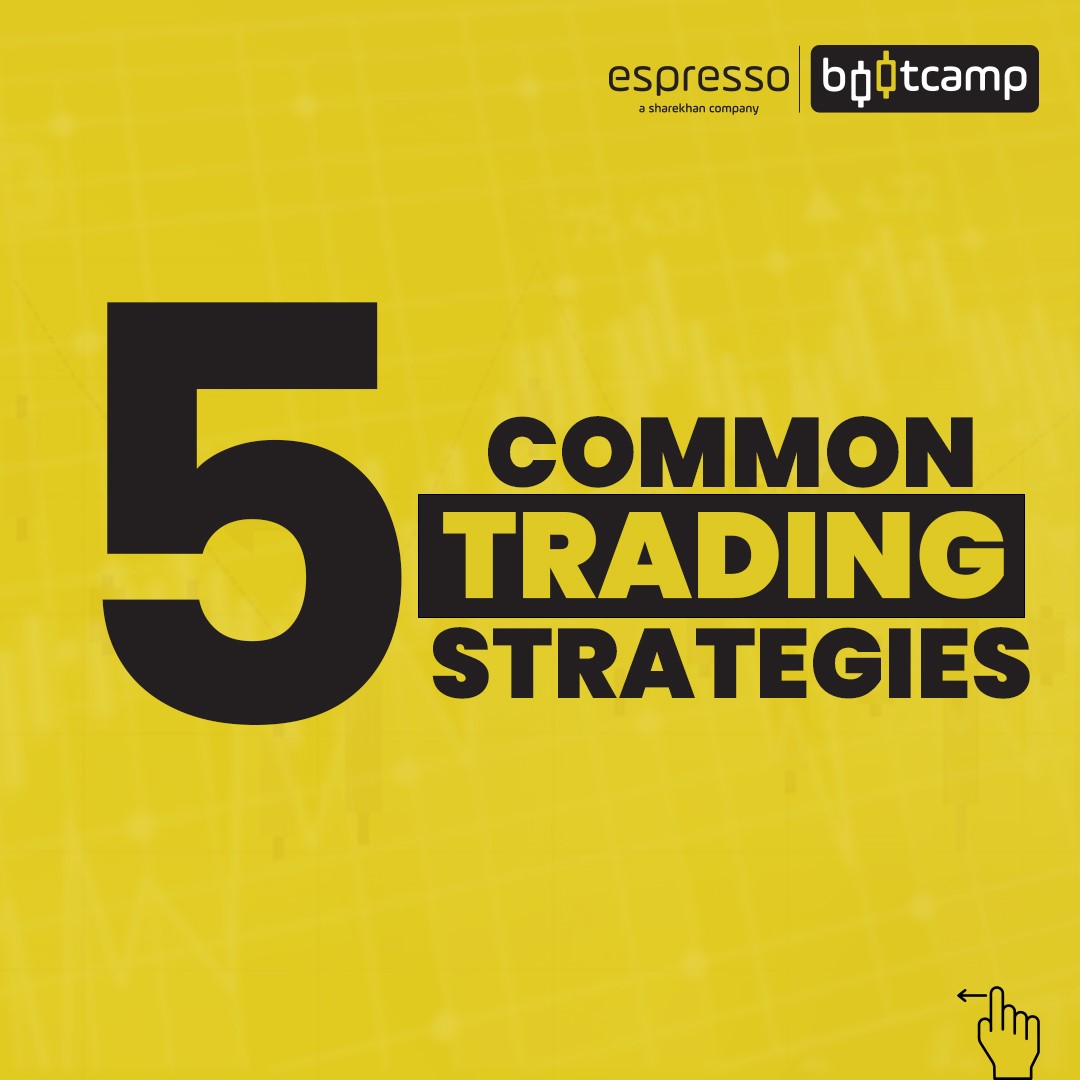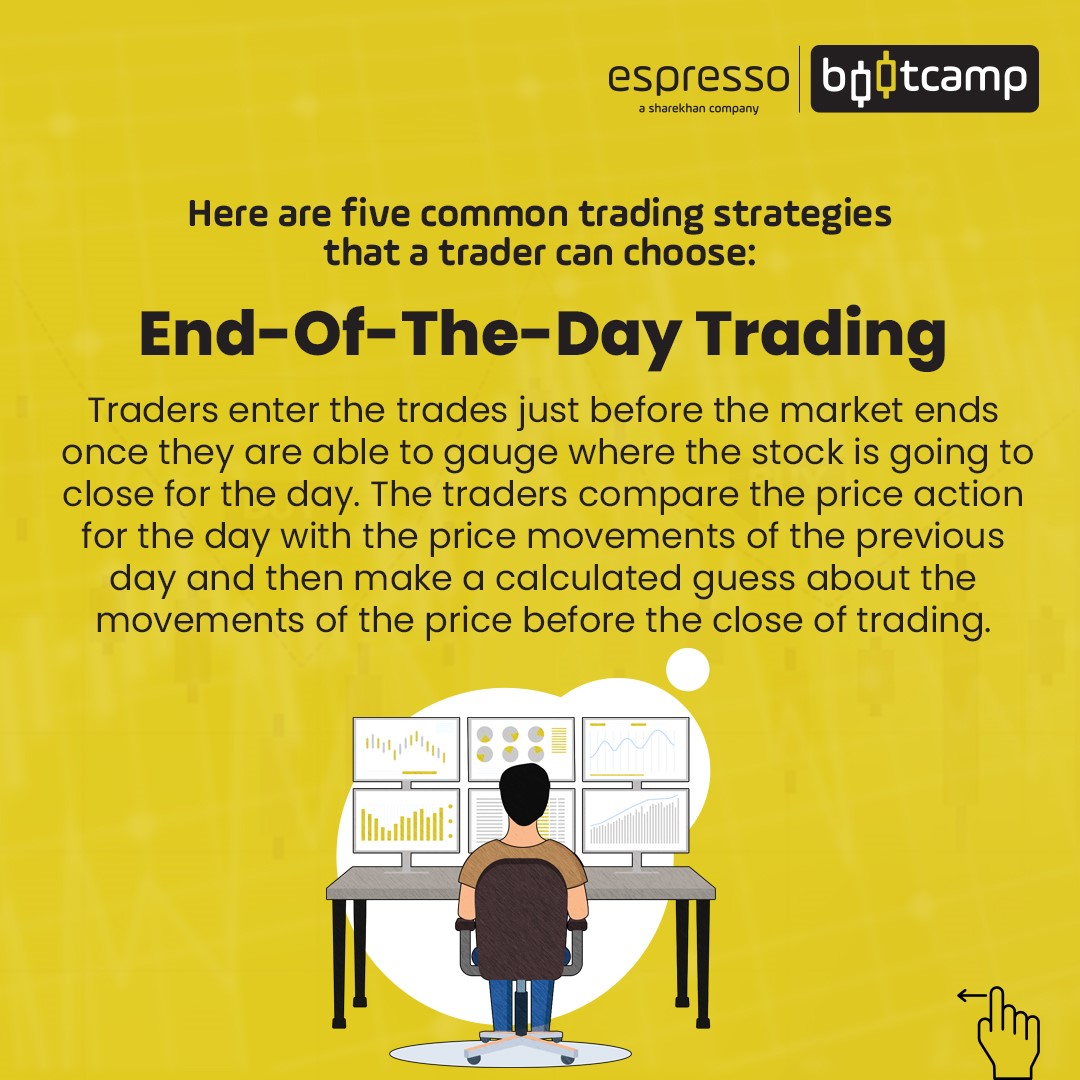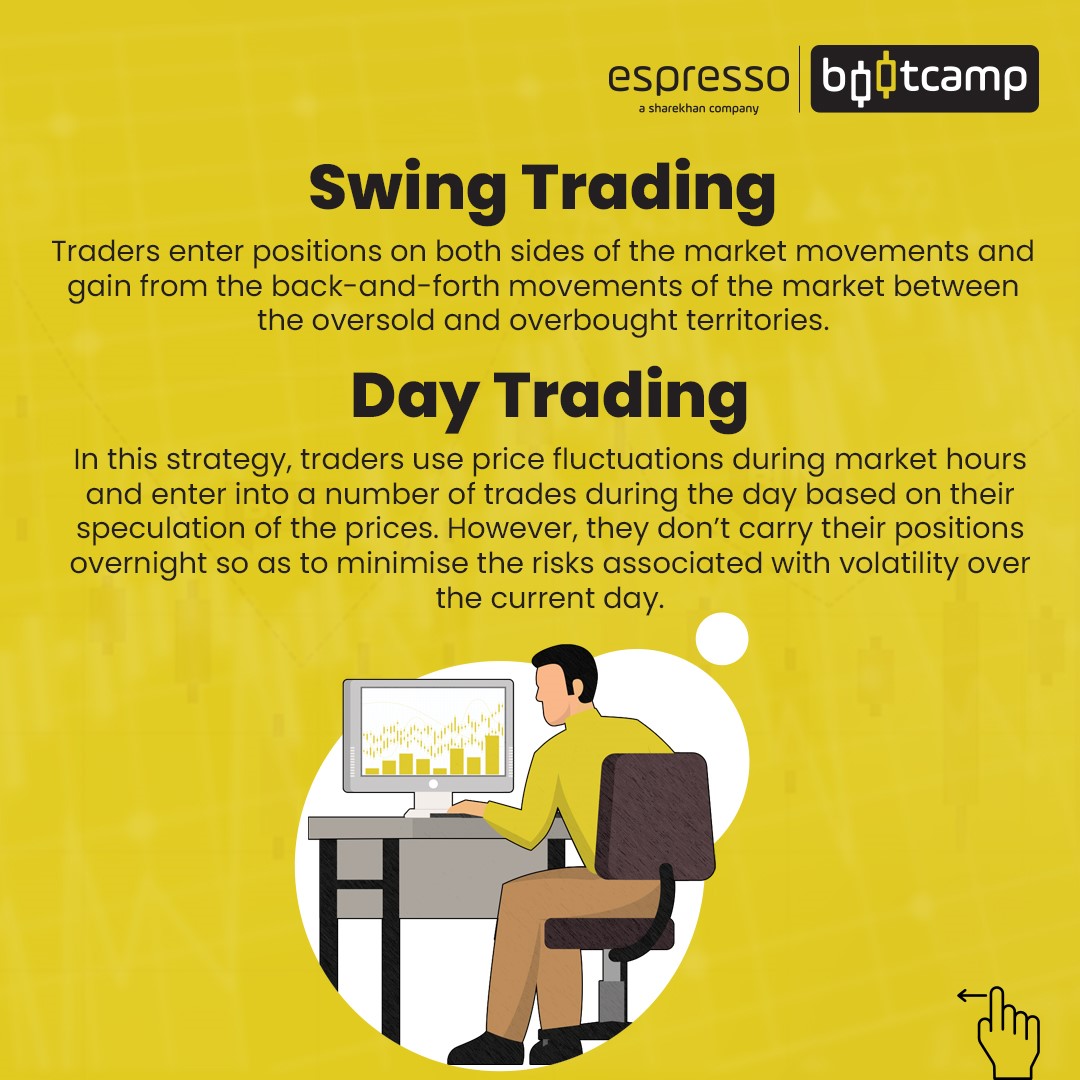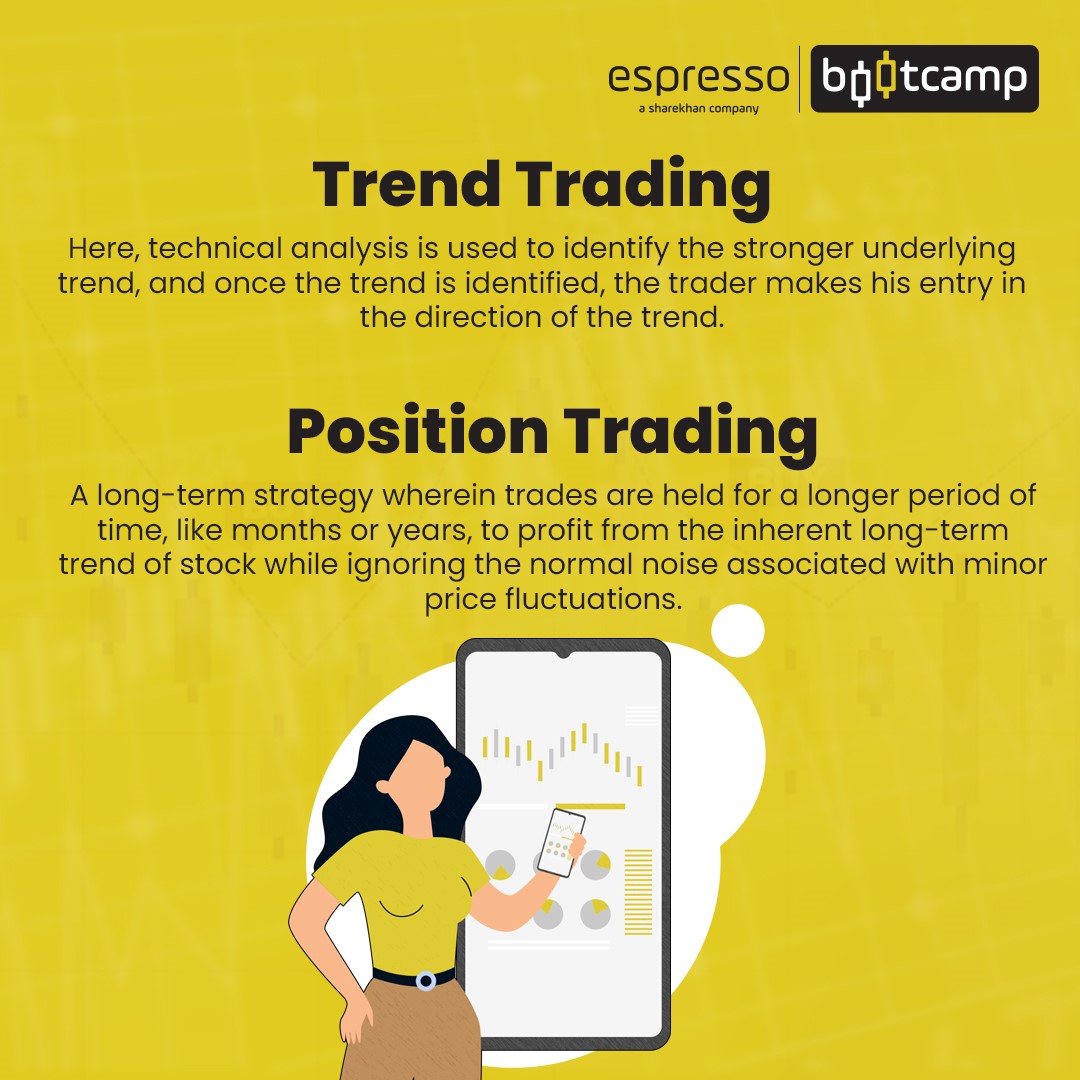Success in stock trading depends on the trading strategy adopted by an individual trader, and it is not at all necessary that one strategy that might be doing wonders for one trader will also reap profits for other traders.
Also, a trader cannot depend on a single strategy for executing the trades, as the same strategy may not work well in all market conditions. Thus, it is always important to master and follow a set of strategies which can be applied either in isolation or combination as per the requirements of the situation.




Some of the factors that a trader needs to consider while deciding on a trading strategy include the type of his personality, the kind of lifestyle he leads and the quantum of resources at his disposal.
Some of the five most common trading strategies that a trader can choose from include:
End-of-the-day trading strategy
As is evident from the name of the strategy, the traders use this strategy to trade near the close of the markets. They look to enter the trades just before the market closes once they are able to gauge where the stock is going to close or settle for the day.
The traders compare the price action for the day with the price movements of the previous day and then make a calculated guess about the movements of the price before the close of trading.
They also make use of certain indicators that are comfortable with and manage their risk by putting a limit order, a stop loss order as well a take-profit order. These orders help them minimise the overnight risk.
This strategy is not as time intensive as some of the other trading strategies because it doesn’t require continuous monitoring of the price movements. Traders can study and analyse the charts to place market orders, even during the night or early morning. This strategy could be a stepping stone for beginners as this doesn’t warrant multiple positions.
Swing trading strategy
The traders using this strategy enter positions on both sides of the market movements. The principle applied in the usage of this strategy is to ‘buy’ a stock when a trader believes that the markets will have an upward movement.
Conversely, they ‘sell’ a stock when their perception is that markets will witness a decline. The traders gain from the back-and-forth movements of the market between the oversold and overbought states.
Swing traders master the strategy by analysing the charts and price movements to gain insights into the bigger underlying trends. The important point to note here, and which can make all the difference between the success or failure of the strategy, is to gauge correctly the length and time for which a swing will last by arriving at the right support and resistance levels.
Also, an eye needs to be kept to identify the trends where there is a surge in demand or supply of a stock and whether the momentum of each individual swing is increasing or decreasing. Swing trading is generally used by traders who have a paucity of time, but it does require research on the part of traders to understand the pattern of oscillations.
Also, since it involves trading on either side of the movement, this strategy provides a number of opportunities to enter into a trade. The risk of holding a trade overnight adds to the risks associated with the trade, so it is always prudent to trade using a stop loss.
Day Trading Strategy
This strategy is one of the most active trading strategies used by traders who wish to trade the entire day and have opted for trading as a full-time profession. The strategy makes use of price fluctuations during market hours. The traders usually enter into a number of trades during the day based on their speculation of the prices, but they don’t carry their positions overnight so as to minimise the risks associated with volatility over the current day.
Traders make use of support and resistance levels as well as the impact of any overnight developments in the global markets on the stock to predict the price movement during the day. The major benefits of intra-day trading are that it does not entail any overnight risk since the trades are closed the same day before the market close.
It provides the flexibility of trading for a few hours in a number of trades and exiting the trades once the day’s targets are achieved. Discipline is the key while using this strategy, and a trader must have fixed entry and exit prices to minimise the risks.
Trend trading strategy
A trader makes use of technical analysis to identify the stronger underlying trend, and once the trend is identified, he makes his entry in the direction of the trend.
Trend trading should not be mixed with being bullish or bearish, as these are the views a trader might have and might base his strategy on the same. But just holding a view about the markets is not a strategy in itself.
Trend traders, on the other hand, do not have a pre-conceived view about the direction in which the market will move.
The success of this strategy depends to a large extent on having a proper trading system in place, which helps in correctly determining the market trends. However, since the trends can change within no time, this strategy always requires alertness and adaptability on the part of traders.
As discussed above, in other trading strategies, a trader can minimise his risk due to trend reversals with the help of a trailing stop loss order. The flip side of using this strategy is that a trend trade can remain open for a number of days depending on the length and duration of the trend and which makes it more susceptible to overnight risks, volatility and uncertainty associated with the next trading session.
Position trading strategy
This is one of the most popular trading strategies used not only by traders having a long horizon but even day traders who park some of their capital in such trades where the outlook of the stock looks positive in the near future.
The basic principle of this strategy is to hold a trade for a longer period of time, like weeks, months or even years, to profit from the inherent long-term trend of stock while ignoring the normal noise associated with minor price fluctuations.
These trading strategies are different from the trading styles that one may choose. A trading style is a trader’s approach to trading based on their financial goals, risk appetite and psychology. Meanwhile, a trading strategy is a set of specific rules, or parameters, that guide decision making about when, where, and how to enter and exit trades. It also includes the type of analysis used to determine potential trades and the risk management techniques used to protect against losses.
Fundamental analysis is the basis of identifying a stock for investment from a long-term perspective, and it takes into consideration the sectoral outlook, market trends and patterns, future plans of the business, and likely competition, among other things. The possibility of good returns is high in this strategy as it ignores the market noise and allows the usage of high leverage to the traders as there is a minimum possibility of committing a mistake.
Also, since the investment is from a long-term perspective, it does not add to the stress associated with other trading strategies like intraday. However, there is a flip side to it, as the trend reversals can be swift, and failure to keep track of the price movements can result in some losses.
The traders should make it a point that a single trading strategy will not be applicable to all kinds of trades or market situations. Adaptability is the key, and hence it always makes sense to have a backup in the form of other strategies which can be applied in case one strategy fails.
Points to remember:
- A trader needs to consider his personality, lifestyle, and resources when deciding on a trading strategy.
- Position trading strategy is a long-term strategy used to profit from the underlying trends of stocks while ignoring short-term price fluctuations.
- While a day trader uses price fluctuations during market hours, a trend trader does not have a pre-conceived view about the direction in which the market will move.
- Adaptability is essential when choosing a trading strategy as a single strategy may not be applicable to all market situations.
 0
|
0
|
 0
0
 Modules
Modules

 Watch
Watch 
